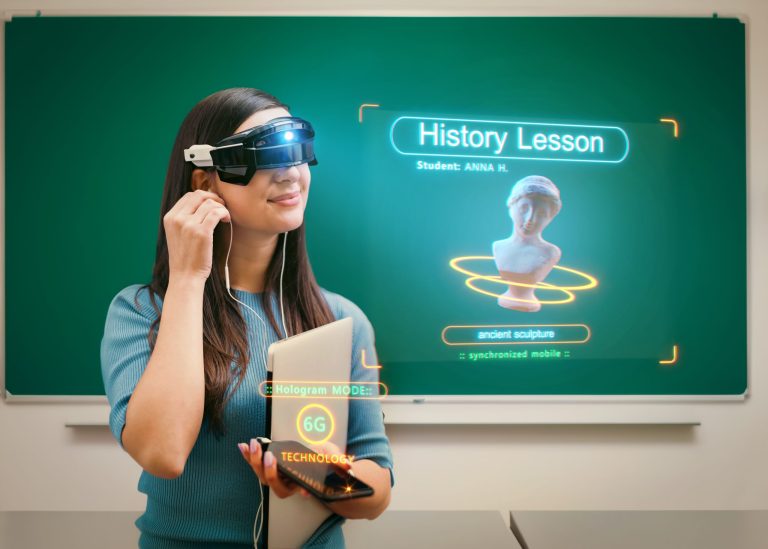From Classroom to Screen: Navigating the New Era of Digital Education
Outline of the Article
- Introduction to Digital Education
- Definition and significance
- Evolution from traditional classrooms to digital platforms
- Advantages of Digital Education
- Flexibility and accessibility
- Personalized learning experiences
- Enhanced engagement through multimedia content
- Challenges Faced in Digital Education
- Technical issues and digital divide
- Maintaining student motivation and focus
- Ensuring effective teacher-student interaction
- Innovative Teaching Methods in the Digital Era
- Interactive online lectures and discussions
- Gamification and virtual simulations
- AI-powered learning tools and chatbots
- Digital Education Platforms and Tools
- Learning Management Systems (LMS)
- Video conferencing tools
- E-books and online resources
- Impact of Digital Education on Students
- Improved self-discipline and time management skills
- Global exposure and cultural diversity
- Development of digital literacy and technical skills
- The Role of Educators in Digital Education
- Adapting teaching methods for online platforms
- Providing emotional support and encouragement
- Fostering a sense of community in virtual classrooms
- Addressing the Digital Divide
- Initiatives to bridge the gap in internet access
- Providing devices and technical support to underprivileged students
- Future Trends in Digital Education
- Artificial Intelligence and Machine Learning in education
- Augmented Reality (AR) and Virtual Reality (VR) applications
- Blockchain technology for secure certifications and assessments
- Conclusion
- Recap of the advantages and challenges of digital education
- Emphasizing the importance of adapting to the new era of learning
- FAQs
- Frequently asked questions related to digital education
- Clear and concise answers to address common queries
From Classroom to Screen: Navigating the New Era of Digital Education
In today’s fast-paced world, the traditional classroom setting has undergone a remarkable transformation. The rise of digital education has paved the way for a new era of learning, bringing education from the confines of physical classrooms to the vast expanse of the internet. This shift has not only changed the way students access information but has also revolutionized the teaching methods employed by educators worldwide.
Introduction to Digital Education
Digital education, also known as online learning or e-learning, refers to the use of digital technology to deliver educational content and facilitate interactive learning experiences. It encompasses a wide range of tools, platforms, and applications that leverage the power of the internet to connect students and teachers regardless of geographical barriers. This innovative approach to education has gained immense popularity, especially in recent years, owing to its numerous advantages.
Advantages of Digital Education
Flexibility and Accessibility
One of the key benefits of digital education is the flexibility it offers to both students and educators. Learners can access course materials and lectures at their own pace, allowing them to balance their studies with other commitments such as work or family responsibilities. Additionally, digital education eliminates geographical constraints, enabling students from diverse backgrounds to participate in educational programs offered by institutions worldwide.
Personalized Learning Experiences
Digital education platforms utilize advanced algorithms to analyze students’ learning patterns and preferences. By doing so, these platforms can provide personalized recommendations and adaptive content tailored to individual needs. This personalized approach enhances the learning experience, making it more engaging and effective.
Enhanced Engagement through Multimedia Content
Traditional textbooks and lectures are often limited in their ability to capture students’ attention. Digital education, on the other hand, incorporates multimedia elements such as videos, interactive simulations, and animations. These engaging materials not only make learning more enjoyable but also enhance understanding and retention of complex concepts.
Challenges Faced in Digital Education
However, the transition from classrooms to screens is not without its challenges. One of the significant hurdles is the digital divide, which refers to the gap between individuals who have access to modern information and communication technology and those who do not. This disparity in internet access and technological resources can hinder the learning opportunities for disadvantaged students.
Maintaining Student Motivation and Focus
Another challenge faced in digital education is the struggle to keep students motivated and focused. Unlike traditional classrooms, online learning environments lack face-to-face interactions, making it easier for students to become disengaged. Educators need to employ creative teaching methods and interactive activities to maintain students’ interest and motivation.
Ensuring Effective Teacher-Student Interaction
Effective communication between teachers and students is essential for a successful learning experience. In digital education, establishing meaningful interactions can be challenging, especially in large online classes. Educators must actively participate in discussions, provide timely feedback, and create a supportive virtual environment to foster a sense of connection among students.
Innovative Teaching Methods in the Digital Era
To address these challenges, educators are adopting innovative teaching methods that leverage the capabilities of digital platforms. Interactive online lectures and discussions allow real-time interaction between teachers and students, fostering engaging learning experiences. Gamification, the integration of game elements into educational activities, adds an element of fun and competition, motivating students to actively participate and excel in their studies.
AI-Powered Learning Tools and Chatbots
Artificial Intelligence (AI) has revolutionized digital education by offering intelligent tutoring systems and chatbots that provide instant assistance to students. These AI-powered tools can analyze students’ responses, identify areas of improvement, and offer personalized recommendations. Chatbots, equipped with natural language processing capabilities, can answer students’ queries promptly, enhancing their learning experience.
Digital Education Platforms and Tools
Various digital education platforms and tools have emerged to cater to the diverse needs of learners and educators. Learning Management Systems (LMS) serve as central hubs where teachers can organize course materials, assignments, and assessments. Video conferencing tools facilitate live online classes and virtual meetings, enabling real-time interaction among participants. Additionally, e-books, online libraries, and educational websites offer a vast repository of resources, making learning accessible to everyone.
Impact of Digital Education on Students
The adoption of digital education has a profound impact on students, shaping their skills, attitudes, and perspectives. One of the notable outcomes is the development of self-discipline and time management skills. Digital learners have the freedom to create their study schedules, honing their ability to manage time effectively—a valuable skill in today’s competitive world.
Global Exposure and Cultural Diversity
Digital education transcends geographical boundaries, allowing students to connect with peers and educators from different parts of the world. This global exposure enhances cultural diversity, fostering tolerance, understanding, and acceptance of different cultures and perspectives. Students gain insights into international perspectives, preparing them to navigate a globalized workforce successfully.
Development of Digital Literacy and Technical Skills
Engaging with digital education equips students with essential digital literacy and technical skills. Proficiency in using various digital tools and platforms becomes second nature, empowering students to adapt to evolving technologies. These skills are invaluable in the digital age, where technology plays a central role in various fields, including business, healthcare, and communications.
The Role of Educators in Digital Education
Educators play a pivotal role in the success of digital education initiatives. Adapting teaching methods for online platforms requires creativity and innovation. Interactive discussions, multimedia presentations, and collaborative projects are some of the strategies educators employ to create engaging virtual classrooms. Moreover, providing emotional support and encouragement to students is crucial, especially during challenging times, ensuring they feel valued and motivated to excel in their studies.
Fostering a Sense of Community in Virtual Classrooms
Building a sense of community is essential in digital education. Educators can create virtual spaces where students can collaborate, share ideas, and support one another. Discussion forums, group projects, and online events foster a sense of belonging, creating a supportive learning environment. When students feel connected to their peers and educators, they are more likely to actively participate and thrive academically.
Addressing the Digital Divide
Addressing the digital divide is a collective effort that involves governments, educational institutions, and communities. Initiatives to bridge the gap in internet access include providing subsidized internet plans to low-income families, establishing community Wi-Fi zones, and equipping schools with high-speed internet connections. Additionally, supplying devices such as laptops and tablets to underprivileged students ensures they can participate in online learning without hindrance.
Providing Devices and Technical Support to Underprivileged Students
Ensuring that every student has access to the necessary devices and technical support is crucial. Educational institutions and charitable organizations can collaborate to provide laptops, tablets, and smartphones to students in need. Moreover, offering technical support services, such as troubleshooting assistance and internet connectivity solutions, ensures that students can overcome technical challenges and focus on their studies.
Future Trends in Digital Education
As technology continues to advance, the future of digital education holds exciting possibilities. Artificial Intelligence (AI) and Machine Learning (ML) are expected to play a significant role in education. AI-driven personalized learning platforms will analyze students’ learning behaviors and preferences, tailoring educational content to meet their individual needs. Machine Learning algorithms will assist educators in assessing students’ performance, identifying areas for improvement, and providing targeted interventions.
Augmented Reality (AR) and Virtual Reality (VR) Applications
Augmented Reality (AR) and Virtual Reality (VR) technologies are poised to transform the learning experience. AR overlays digital content onto the real world, enhancing interactive learning activities. VR, on the other hand, creates immersive virtual environments where students can explore historical landmarks, conduct virtual experiments, or even travel to outer space—all from the comfort of their homes. These technologies bring learning to life, making education engaging, memorable, and impactful.
Blockchain Technology for Secure Certifications and Assessments
Blockchain technology offers secure and transparent solutions for certifications and assessments. Academic credentials, such as diplomas and certificates, can be securely stored on a blockchain, ensuring their authenticity and integrity. Additionally, assessments conducted on blockchain platforms are tamper-proof, enhancing the credibility of online certifications. This technology provides a reliable way to verify students’ achievements, making online education more trustworthy and credible.
Conclusion
In conclusion, the transition from classroom to screen has ushered in a new era of digital education, revolutionizing the way we learn and teach. While it presents challenges such as the digital divide and maintaining student engagement, the benefits are vast and transformative. Digital education offers flexibility, personalized learning experiences, and enhanced engagement through multimedia content. Educators, students, and policymakers must collaborate to address challenges, ensuring that every learner has access to quality education.
FAQs
Q1: Is digital education suitable for all age groups?
A1: Yes, digital education caters to learners of all age groups, from primary school students to lifelong learners seeking professional development opportunities. There are specialized online courses and resources tailored to different age brackets and learning goals.
Q2: How can educators maintain a sense of community in virtual classrooms?
A2: Educators can foster a sense of community by organizing online group activities, virtual study sessions, and collaborative projects. Discussion forums and social media groups dedicated to the course also provide platforms for students to interact and support one another.
Q3: Are online certifications and degrees recognized by employers?
A3: Yes, many reputable institutions and universities offer online certifications and degrees that are widely recognized by employers. However, it’s essential to choose accredited programs and institutions to ensure the credibility of the certification.
Q4: What role does parental involvement play in digital education?
A4: Parental involvement is crucial in supporting students’ online learning experiences. Parents can create a conducive learning environment at home, monitor their children’s progress, and communicate with educators to stay informed about their child’s academic performance.
Q5: How can governments bridge the digital divide in education?
A5: Governments can bridge the digital divide by investing in infrastructure to provide high-speed internet access to underserved areas. Subsidized internet plans, community Wi-Fi zones, and providing devices to low-income families are essential initiatives to ensure equal educational opportunities for all.






